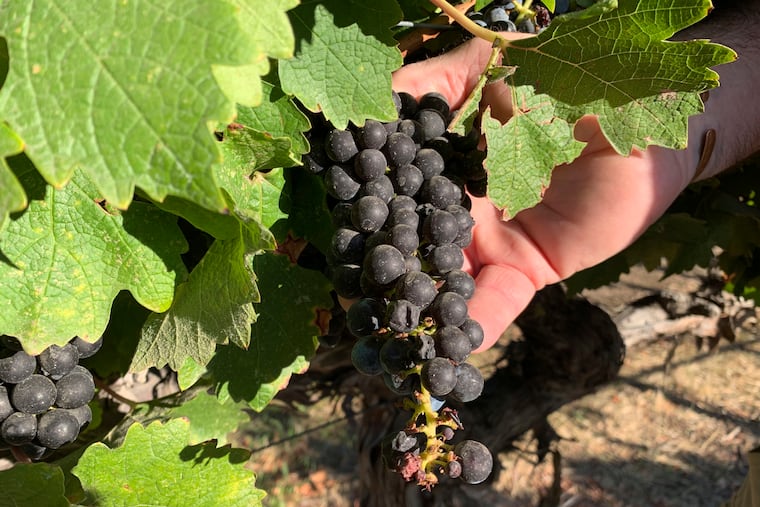Climate change could shrink more than half of all wine regions. What will it mean for Pa., N.J. wineries?
Regions of the world world suitable for growing the most common wine grapes could shrink more than half, according to a new study. Although the study did not look specifically at Pennsylvania or New Jersey, it suggests both would be impacted severely. But there are steps growers can take.

Never heard of mourvedre? You might want to develop a taste for the rustic, full-bodied red wine because it could be crowding out such other wines as pinot noir on the shelves in coming decades due to climate change, a new study suggests.
Some of the most suitable regions of the world for wine grape growing could shrink by more than half if temperatures keep rising, and local regions wouldn’t be spared, according to a study published Monday in the Proceedings of the National Academy of Sciences.
Although the study did not look specifically at the impact in Pennsylvania or New Jersey, both states could be affected through different aspects of climate change such as extreme weather events.
The authors of the study say growers can significantly reduce the decline by planting different grape varieties. So the more heat-loving mourvedre could replace cooler-loving pinot noir in France’s Burgundy region, for example.
The international team of researchers was led by Ignacio Morales-Castilla at the University of Alcalá in Spain and Elizabeth Wolkovich at the University of British Columbia, Vancouver. The team examined 11 varieties of wine grape: cabernet sauvignon, chasselas, chardonnay, grenache, merlot, monastrell, pinot noir, riesling, sauvignon blanc, syrah and ugni blanc.
They studied the potential impact of temperature increases of 0, 2, and 4 degrees Celsius. They chose to use wine grapes as a barometer of the effects of climate change because detailed growing records stretch back hundreds of years. Wine grapes also are acutely sensitive to changes in weather.
The scientists looked at the impact that warming would have on the plants’ developmental stages, such as when they bud and mature. The team estimated that regions of the world suitable for growing wine grapes could shrink by as much as 56% under an increase of 2 degrees Celsius (3.6 degrees Fahrenheit).
Further, 85% of those lands would no longer be able to produce good wines under an increase of 4 degrees Celsius (7.2 F).
Though losses were unavoidable in either warming scenario, the scientists say changing the growing locations of certain varieties could reduce the losses by half under the 2-degree Celsius rise, possible by 2040 under their modeling.
“In some ways, wine is like the canary in the coal mine for climate change impacts on agriculture, because these grapes are so climate-sensitive,” said study co-author Benjamin Cook from Columbia University’s Lamont-Doherty Earth Observatory and the NASA Goddard Institute for Space Studies.
The cooler regions of Germany and the U.S. Pacific Northwest would mostly escape losses under a 2-degree scenario. In addition, they could even become suitable for growing merlot and grenache.
Wine-growing regions that are hot now — such as Italy, Spain, and Australia — faced the largest losses, because they are already limited to planting the most heat-tolerant varieties.
Switching varieties, however, could be met with cultural and gastronomic resistance.
“Conversations in Europe have already begun about new legislation to make it easier for major regions to change the varieties they grow,” said Wolkovich at the University of British Columbia, Vancouver. “But growers still must learn to grow these new varieties. That’s a big hurdle in some regions that have grown the same varieties for hundreds and hundreds of years, and they need consumers who are willing to accept different varieties from their favorite regions.”
What about locally? The wine scenes in both Pennsylvania and New Jersey have boomed with the establishment of wine trails and more farmers learning that vineyards and tasting rooms provide new income.
Lead author Morales-Castilla wrote in an email that some parts of the Eastern U.S. would lose at least some suitability for growing certain varieties of grapes.
“I think it is safe to say that under warming scenarios, climate conditions to grow those varieties are expected to change significantly,” he wrote.
Dan Ward, director of Rutgers University’s Agricultural Research and Extension Center in Cumberland County, said that a few degrees of warming in the region won’t have the same economic impact on grape growers as in the well-established global markets of Europe and elsewhere.
Ward was not affiliated with the study and said he could not address its methods and findings.
But he noted that New Jersey with its nascent market can be more flexible than tradition-bound European growers, so temperature change would not be as disruptive.
Rather, Ward said the bigger local concern is the extreme weather events farmers are already experiencing due to climate change. Storms, wind, sodden ground, and sudden shifts in temperature can wipe out entire plantings.
“So that’s more damaging than a few degrees of heat,” Ward said. “A severe rainstorm can eliminate an entire year’s crop. A severe change in weather can kill vines. Those kinds of extreme events are increasing in frequency, and that is a huge threat.”